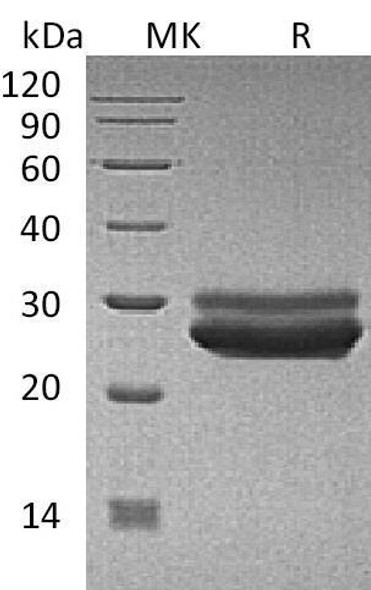Description
| Product Name: | Recombinant Sheep Prolactin/PRL (C-6His) |
| Product Code: | RPES6769 |
| Size: | 10µg |
| Species: | Sheep |
| Expression Host: | HEK293 Cells |
| Synonyms: | Prolactin, PRL |
| Mol Mass: | 23.5 kDa |
| AP Mol Mass: | 25-30 kDa |
| Tag: | C-6His |
| Purity: | > 95 % as determined by reducing SDS-PAGE. |
| Endotoxin Level: | < 1.0 EU per μg of the protein as determined by the LAL method. |
| Bio Activity: | Testing in progress |
| Sequence: | Thr31-Cys229 |
| Accession: | P01240 |
| Storage: | Generally, lyophilized proteins are stable for up to 12 months when stored at -20 to -80°C. Reconstituted protein solution can be stored at 4-8°C for 2-7 days. Aliquots of reconstituted samples are stable at < -20°C for 3 months. |
| Shipping: | This product is provided as lyophilized powder which is shipped with ice packs. |
| Formulation: | Lyophilized from a 0.2 μm filtered solution of 20mM Tris-HCl, 150mM NaCl, pH 8.0. Normally 5 % - 8 % trehalose, mannitol and 0.01% Tween80 are added as protectants before lyophilization. Please refer to the specific buffer information in the print |
| Reconstitution: | Please refer to the printed manual for detailed information. |
| Background: | Prolactin (PRL) is a secreted neuroendocrine pituitary hormone that acts primarily on the mammary gland to promote lactation, but has pleiotropic effects in both males and females. Non-glycosylated prolactin is produced by the pituitary and packaged in storage granules before secretion, while glycosylated prolactin is reported to be constitutively secreted, have lower biological potency, and be removed from the circulation more quickly. Prolactin is synthesized mainly by the anterior pituitary in all mammals, where secretion is under tonic inhibition by hypothalamic dopamine. In humans, prolactin is also produced peripherally. Prolactin expression is low during early human pregnancy, but increases in late pregnancy. The prolactin receptor (PRLR) is a transmembrane type I glycoprotein that belongs to the cytokine hematopoietic receptor family. prolactin molecule is thought to bind two receptor molecules. In addition to its lactogenic activity, peripherally produced prolactin plays roles in breast and prostate cancer development, regulation of reproductive function, and immunoregulation. |






